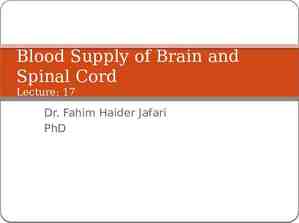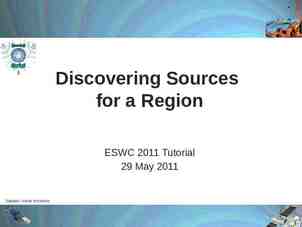CHAPTER 12 AN OPTIONS PRIMER In this chapter, we provide
50 Slides236.00 KB

CHAPTER 12 AN OPTIONS PRIMER In this chapter, we provide an introduction to options. This chapter is organized into the following sections: 1. Options and Options Markets 2. Options Pricing 3. The Option Pricing Model 4. Speculating with Options 5. Hedging with Options Chapter 12 1

Options and Options Markets Options Options are specialized financial instruments that give the purchaser the right but not the obligation to do something. That is, the purchaser can do something if he/she wants to, but he/she does not have to do it. Options are a relatively new financial instruments dating back to the 1970’s. IBM Example: IBM common stocks trades at 120, an investor has an option to buy a IBM stock for 100 through August in the current year. Chapter 12 2

Options and Options Markets There are two classes of options referred to as put and call options. You may purchase or sell either a call option or a put option. Put and call options each give buyers and sellers different rights and responsibilities as follows: Call Options The buyer of a call option has the right but not the obligation to purchase a pre-specified amount of a prespecified asset at a pre-specified price during a prespecified time period. The seller of a call option has the obligation to sell a prespecified amount of a pre-specified asset at a pre-specified price if asked to do so during a pre-specified time period. Chapter 12 3

Options and Options Markets Put Options The buyer of a put option has the right but not the obligation to sell a pre-specified amount of a pre-specified asset at a pre-specified price during a pre-specified time period. The seller of a put option has the obligation to purchase a pre-specified amount of a pre-specified asset at a prespecified price if asked to do so during a pre-specified time period. Chapter 12 4

Options and Options Markets Terminology The Premium The buyer of an option pays the seller of the option a premium on the day that the agreement is entered into. The Strike Price or the Exercise Price The pre-specified price is referred to as the strike or the exercise price. Expiration The amount of time specified in the options contract. Exercise The option buyer elects to utilize his/her right. – In the case of a call option, the buyer utilizes his/her right to buy the stock. – In the case of a put option, the buyer utilizes her/his right to sell the stock. Chapter 12 5

Options and Options Markets Terminology Option Writer The seller of an option. Writing an Option The act of selling an option. European Options European options can be exercised only on the maturity date. American Options American options can be exercised any time prior to maturity. Covered Call Writing call options against stock that the writer owns. Naked Option Writing a call option on a stock that the writer does not own. Chapter 12 6

Options and Options Markets Terminology Intrinsic Value The value of an option if it is exercised immediately. Option Clearing Corporation (OCC) Oversees the conduct of the market and helps to make the market orderly. Option buyers and sellers only obligations are to the OCC. If an option is exercised, the OCC matches buyers and sellers, and manages the completion of the exercise process. Chapter 12 7

Call Option Example You buy a call option on 100 shares of IBM stock with a strike price of 50 per share and a premium of 2.50 per share. The option has 3 months to maturity. Suppose that at the time you enter into the contract, the price of IBM stock is 49.50 The buyer pays the seller a 2.50 premium on the day they enter into the agreement. Timeline: 0 2 1 3 - 2.50 Chapter 12 8

Call Option Example After three months the stock price will have either gone up, gone down, or stayed the same. A. Suppose that after three months the price of IBM stock has gone down to 47 per share. – The option will expire worthless: that is, the buyer will not exercise his/her right to purchase the shares for 50 per share. – The purchaser of the option loses the 2.50 per share premium. B. Suppose that after three months, the price of IBM stock has stayed at 49.50 per share. – The option will expire worthless: that is, the buyer will not exercise her/his right to purchase the shares for 50 per share. – The purchaser of the option loses the 2.50 per share premium. Chapter 12 9

Call Option Example C. Suppose that after three months, the price of IBM stock has gone up to 70 per share. In this case, the buyer of the call option will exercise his option. – The purchaser of the option will exercise his/her right to purchase 100 shares for 50 per share. – The purchaser will then go to the market to sell his/her share of stock for 70 per share. Thus the purchaser makes a profit Chapter 12 10

Put Option Example You buy a put option on 100 shares of IBM stock with a strike price of 50 per share and a premium of 2.50 per share. The option has 3 months to maturity. Suppose that at the time you enter into the contract, the price of IBM stock is 50.50 The buyer pays the seller a 2.50 premium on the day they enter into the agreement. Timeline: 0 2 1 3 - 2.50 Chapter 12 11

Put Option Example After three months the stock price will have either gone up, gone down, or stayed the same. A. Suppose that after three months the price of IBM stock has gone down to 45 per share. – The buyer of option will exercise her/his option to sell the stock for 50. – Thus, the buyer will purchase the stock for 45 in the market and sell it using the put option for 50. – The purchaser of the put option makes a profit B. Suppose that after three months, the price of IBM stock has stayed at 50.50 per share. – The option will expire worthless: that is, the buyer will not exercise her/his right to sell the shares for 50 per share. – The purchaser of the option loses the 2.50 per share premium. Chapter 12 12

Put Option Example C. Suppose that after three months, the price of IBM stock has gone up to 70 per share. In this case, the buyer of the put option will not exercise his/her option. – The option will expire worthless: that is, the buyer will not exercise his/her right to sell the shares for 50 per share. – The purchaser of the option loses 2.50 per share premium. Chapter 12 13

Option Exchanges Table12.1 Principal Options Exchanges and Option Traded Exchange Option Traded Panel 1: Options Exchanges in the United States Chicago Board Options Exchange (CBOE) Options on Individual Stocks LongBTerm Options on Individual Stocks Options on Stock Indexes Options on Interest Rates American Stock Exchange (AMEX) Options on Individual Stocks LongBTerm Options on Individual Stocks Options on Stock Indexes Options on Exchange Traded Funds Philadelphia Stock Exchange (PHLX) Options on Individual Stocks LongBTerm Options on Individual Stocks Options on Stock Indexes Options on Foreign Currency Pacific Exchange (PSE) Options on Individual Stocks LongBTerm Options on Individual Stocks International Securities Exchange (ISE Boston Options Exchange (BOX) Chicago Mercantile Exchange (CME) Chicago Board of Trade (CBOT) New York Mercantile Exchange (NYMEX) New York Board of Trade (NYBOT) Kansas City Board of Trade (KCBT) Minneapolis Grain Exchange (MGE) Options Options Options Options Options Options Options Options on Individual Stocks on Individual Stocks on futures traded at the CME on futures traded at the CBOT on futures traded at NYMEX on futures traded at the NYBOT on futures traded at the KCBT on futures traded at the MGE Panel 2: Key Options Exchanges Outside the United States Eurex (Germany and Switzerland) Options on individual stocks Options on futures Euronext (Brussels, Amsterdam, Paris,& London) Options individual stocks Options on Stock Indexes Option on Interest rates Euronext.liffe (Brussels, Amsterdam, Paris, & London) Options on futures Chapter 12 14

Option Quotations Insert Figure 12.1 here Chapter 12 15

Option Pricing Five factors affect the price of options on stocks without cash dividends: Factor Name S E T σ r Call Put Option Option Stock Price Exercise Price Time Volatility of Underline Stock (Standard Deviation) Risk-Free Interest Rates - This section considers the effects of the first three factors. Thus, a call price can be expressed using: C(S, E, t) Chapter 12 16

Pricing Call Options at Expiration First principle of option pricing At expiration, a call option must have a value that is equal to zero or to the difference between the stock price and the exercise price, whichever is greater. This quantity is referred to as the intrinsic value of the option: C(S, E, 0) max(0, S - E) If this condition does not hold, an arbitrage opportunity exists. Two possibilities may arise, regarding the relationship between the exercise price (E) and the stock price (S). S E S E Where t 0. Chapter 12 17

Pricing Call Options at Expiration First Possibility: S E Example: A call option with an exercise price of 80 on a stock trading at 70. The option is about to expire. If an option is at expiration and the stock price is less than or equal to the exercise price, the call option has no value. Max(0, S-E) Max(0, 70-80) 0 Chapter 12 18

Pricing Call Options at Expiration Second Possibility: S E If the stock price is greater than the exercise price, the call option must have a price equal to the difference between the stock price and the exercise price. Max(0, S-E) S – E If this relationship did not hold, there would be an arbitrage opportunity. Example 1: Consider a call option that is selling with an exercise price of 40 on a stock trading at 50. The option is selling for 5. An arbitrageur would make the following trades: Transaction Cash Flow Buy a call option Exercise the option to buy the stock Sell the stock Net Cash Flow Chapter 12 -5 -40 50 5 19

Pricing Call Options at Expiration Example 2: A call option with an exercise price of 40 on a stock trading at 50. The option is now selling 15. The option is about to expire. An arbitrageur would make the following trades: Transaction Cash Flow Write a call option Buy the stock Initial Cash Flow 15 - 50 - 35 If owner of the call option exercises the option. The arbitrageur’s transactions are: Transaction Cash Flow Initial cash flow Deliver stock Collect exercise price Net Cash Flow - 35 0 40 5 Chapter 12 20

Pricing Call Options at Expiration If the owner of the call option allows the option to expire. The arbitrageur’s transactions are: Initial cash flow Sell Stocks Net Cash Flow - 35 50 15 In order for these arbitrage opportunities not to exist, principle 1 must hold. Chapter 12 21

Graphical Analysis of Option Values and Profits Expiration Assume a call and a put option both with 100 striking price. We can graph the payoff on these options as demonstrated in Figure 12.2. Insert Figure 12.2 Here Chapter 12 22

Option Values and Profits Expiration Assume a call and a put option both with 100 striking price. Trades had taken place for the options with premiums of 5 on each of the put and call options. Figure 12.3 illustrates the alternatives outcomes. Insert Figure 12.3a here Chapter 12 23

Option Values and Profits Expiration Insert Figure 12.3b here Chapter 12 24

Pricing Prior to Maturity Second principle of option pricing: A call option with a zero exercise price and an infinite time to maturity must sell for the same price as the stock. This is because the buyer of the call option can convert his/her option into the stock and sell it. C(S, 0, ) S Combining principle #1 and #2, we can establish bounds for the price of an option. That is, establish upper and lower limits for the price of the option. The bounds for the price of a call option are a function of the stock price, the exercise price, and the time to expiration. Figure 12.4 presents these boundaries. Chapter 12 25

A Call Option with Zero Exercise Price and an Infinite Time until Expiration Insert Figure 12.4 here Chapter 12 26

Relationship Between Option Prices Third principle of option pricing If two call options are alike, except the exercise price of the first is less than that of the second, then the option with the lower exercise price must have a price that is equal to or greater than the price of the option with the higher exercise price. The relationship can be defined as follows: If E1 E2, C(S, E1, t) C(S, E2, t) If this relationship does not hold, an arbitrage profit can be earned. Chapter 12 27

Relationship Between Option Prices Example: You have two identical options. The first option has an exercise price of 100 and sells for 10. The second option has an exercise price of 90 and sells for 5. An arbitrageur would make the following trades: Transaction Cash Flow Sell the option with the 100 exercise price Buy the option with the 90 exercise price 10 -5 Net Cash Flow 5 Figures 12.5a creates an arbitrage opportunity and figure 12.5b graphs the combined positions. Chapter 12 28

Relationship Between Option Prices Insert figure 12.5a here Insert figure 12.5b here Chapter 12 29

Relationship Between Option Prices Consider the profit and loss position on each option and the overall position for alternative stock prices that might prevail at expiration. Profit or Loss on the Option Position Stock Price at Expiration 80 90 95 100 105 110 120 For E 90 For E 100 For Both - 5 - 5 0 5 10 15 25 10 10 10 10 5 0 - 10 5 5 10 15 15 15 15 The result is graphed in figure 12.5c. Chapter 12 30

Relationship Between Option Prices Insert figure 12.5c here Notice in figure 12.5c that regardless of the ultimate stock price, a positive profit is earned. In order to avoid this arbitrage principle 3 must hold. Chapter 12 31

Relationship Between Option Prices Fourth principle of option pricing (expiration date principle) If there are two options that are otherwise alike, the option with the longer time to expiration must sell for an amount equal to or greater than the option that expires earlier. If t1 t2, C(S, t1, E) C(S, t2, E) If the option with the longer period to expiration sold for less than the option with the shorter time to expiration, there would also be an arbitrage opportunity. Chapter 12 32

Relationship Between Option Prices Example: Two options on the same stock both having a striking price of 100. The first option has a time to expiration of 6 months and trades for 8. The second option has 3 months to expiration and trades for 10. An arbitrageur would make the following transactions: Transaction Cash Flow Buy the 6-month option for 8 Sell the 3-month option for 10 Net Cash Flow - 8 10 2 The option with the longer time to expiration must be worth more than the option with the shorter time to expiration. Figure 12.6 illustrate this Chapter 12 33

Relationship Between Option Prices Insert figure 12.6 here Chapter 12 34

Call Option Prices and Interest Rates Example: Assume that a stock now sells for 100. Over the next year, its value can change by 10% in either direction (100 shares equal to 9,000 or 11,000) The risk-free rate of interest is 12%. A call option exists with a striking price of 100/share and expiration one year from now. Assume two portfolios: Portfolio A 100 shares of stock, current value 10,000. Portfolio B A 10,000 pure discount bond maturing in one year, with a current value of 8,929 (PV with 12% interest rate). One option contract, with an exercise price of 100/share ( 10,000/ entire contract) Table 12.2 illustrates the impact of price changes on each portfolio. Chapter 12 35

Call Option Prices and Interest Rates Table 12.2 Portfolio Values in One Year Stock Price Change 10% B10% Portfolio A Stock 11,000 9,000 Portfolio B Maturing Bond Call Option 10,000 1,000 10,000 0 Portfolio B is the best portfolio to hold. If the stock price goes down, Portfolio B is worth 1,000 more than Portfolio A. If the stock price goes up, Portfolios A and B have the same value. This implies that the value of the option should be at least: C S PresentValue(E) C 10,000 - 10,000 1,071 (1.12) Chapter 12 36

Call Option Prices and Interest Rates Fifth principle of option pricing Other things being equal, the higher the risk-free rate of interest, the greater must be the price of a call option. Thus, the interest rate principle can be expressed as: If r1 r2, C(S, E, t, r1) C(S, E, t, r2) Recall that the price of the call must be either zero or S - E at expiration or: C S PresentValue(E) The call price must be greater than or equal to the stock price minus the present value of the exercise price. So the higher the interest rate, the higher the value of call option. Using the data from previous example, now assume that interest rates goes up to 20%. The new value of the option should be: C 10,000 - 10,000 1,667 (1.20) Chapter 12 37

Prices of Call Options and The Riskiness of Stocks Sixth principle of option pricing (the risk principle) The riskier the stock on which an option is written, the greater will be the value of a call option. Thus the sixth principle can be stated as: If σ1 σ2, C(S, E, t, r, σ1) C(S, E, t, r, σ2) Other things being equal, a call option on a riskier good will be worth at least as much as a call option on a less risky good. Chapter 12 38

Prices of Call Options and The Riskiness of Stocks Table 12.3 shows the impact that stock price changes have on option prices. Table 12.3 Portfolio Values in One Year Stock Price Change Portfolio B Maturing Bond Call Option In Portfolio B, the call option must be worth at least 1,071. 10% B10% 10,000 1,000 10,000 0 Stock Price Change 20% B20% Portfolio A Stock 12,000 8,000 Portfolio B Maturing Bond Call Option 10,000 2,000 10,000 0 Chapter 12 39

Option Pricing Model Recall that the price of an option must be at least as great as the stock price minus the present value of the exercise price. However, options have an inherent insurance policy. The insurance character of the option can be seen by comparing the payoffs from Portfolio A and B from Table 12.3. Holding the options insures that the worst outcome from the investment will be 10,000. To reflect this, the value of the option must be equal to the stock price minus the present value of the exercise price, plus the value of the insurance policy (I) inherent in the option or: C(S, E, t, r, σ) S - Present Value(E) I Option pricing models can be used to determined the insurance policy value. Chapter 12 40

Option Pricing Model (OPM) The Black and Scholes Option Pricing Model (OPM) assumes that stock prices follow a stochastic process or Wiener process. Where a stochastic process is a mathematical description of the change in the value of some variable through time. Wiener process shows that the changes over any given time interval are distributed normally. Figure 12.7 shows a graph of the path that stock prices might follow if they followed a Wiener process. Chapter 12 41

Option Pricing Model (OPM) Insert figure 12.7 here Chapter 12 42

Option Pricing Model (OPM) The Black-Scholes OPM is given by: C SN(d1) - E e-rt N(d2) The Black-Scholes OPM can be used to calculate the theoretical price of an option. If we know the value of the following variables: d1 ln(S / E ) r .5 2 t t d 2 d 1 t N (d1 ), N (d 2 ) cumulative normal probability values of d1 and d 2 Where S -E t r σ stock price exercise price time to expiration risk-free interest rate variability of the stock Chapter 12 43

Option Pricing Model (OPM) Example: assume the following values: S E t r σ 100 100 1 year 12% 10% Step 1: calculate the values for d1 and d2. d1 d1 ln(S / E ) r .5 2 t t ln(100 / 100) .12 .5(.01) 1 (.1)(1) d1 0 .1250 1.25 .1 d 2 d 1 t d 2 1.25 (.1)(1) 1.15 Chapter 12 44

Option Pricing Model (OPM) Step 2: calculate N(d1) and N(d2) The cumulative normal probability can be obtained from tables that are widely available or by using the excel function: “ normsdist(d)” Using a standardized normal probability distribution table N(d1) N(d2) N(1.25) .8944 N(1.15) .8749 Step 3: calculate the call option price using OPM C S N(d1) - E e-rt N(d2) C 100 (.8944) - 100 e-(.12)(1) (.8749) C 89.44 - 100 (.8869) (.8749) C 89.44 - 77.60 11.84 The value of the option is 11.84 Recall form Table 12.2 that option value was 10.71. The difference is due to the value of the insurance policy that is captured by the Black-Scholes OPM. Chapter 12 45

The Value of Put Options and Put-Call Parity While the Black-Schole OPM applies to call options, we can infer the corresponding value of a put option by utilizing a concept called Put-Call Parity. The Put-Call Parity tells us that the value of a put option can be computed as follows: P E S C t 1 r For example, suppose a stock is trading for 100 per share. Using the Black-Scholes OPM, we have computed the value of a call option with a 100 striking price to be 11.84. The interest rate is 12%. The value of the put option is computed as: P 100 - 100 11.84 1.13 (1.12) Chapter 12 46

Speculating with Options Using our prior calculations, what would be the effect of a 1% change in stock prices? What are the speculating opportunities? Original Values 1% Increase 1% Decrease S 100 S 101 S 99 C 11.84 C 12.73 C 10.95 Options can be used to take very low risk speculative positions by using options in combinations. The combinations are virtually endless, including combinations called strips, straps, spreads and straddles. Chapter 12 47

Speculating with Options A straddle is a combination of positions involving a put and a call option on the same stock. To buy a straddle, the investor buys both call and put options. Consider a call and put option, both with an exercise price of 100. The call trades for 40 and the put for 7. Table 12.5 shows the payoff on the straddle at various stock prices. Table 12.5 Payoffs for Calls, Puts, and a Straddle at Expiration Stock Price at Expiration Call Profit/Loss Put Profit/Loss Straddle Profit/Loss 50 B 10 43 33 80 B 10 13 3 83 B 10 10 0 85 B 10 8 B 2 90 B 10 3 B 7 95 B 10 B 2 B 12 100 B 10 B 7 B 17 105 B 5 B 7 B 12 110 0 B 7 B 7 115 5 B 7 B 2 117 7 B 7 0 120 10 B 7 3 150 40 B 7 33 Note: Profit/Loss figures reflect the amounts paid for the instruments: Call 10 Put 7 Straddle Call Put 17 Chapter 12 48

Speculating with Options The payoff is graphically displayed in Figure 12.9. Insert figure 12.9 here Chapter 12 49

Hedging with Options Options can be used to control risk. Consider an original portfolio comprised of 8,944 shares of stock selling at 100 per share and assume that a trader sells 100 option contracts, or options on 10,000 shares, at 11.84. The entire portfolio would have a value of 776,000. Table 12.6 shows a hedged portfolio. Table 12.6 A Hedged Portfolio Original Portfolio: S 100 C 11.84 8,944 shares of stock 894,400 A short position for options on 10,000 shares (100 contracts) B 118,400 Total Value 776,000 Stock Price Rises by 1%: S 101 C 12.73 8,944 shares of stock 903,344 A short position for options on 10,000 shares (100 contracts) B 127,300 Total Value 776,044 Stock Price Falls by 1%: S 99 C 10.95 8,944 shares of stock 885,456 A short position for options on 10,000 shares (100 contracts) B 109,500 Total Value 775,956 Notice that by hedging, the value of the portfolio did not change as a result of the change in stock prices. Chapter 12 50






